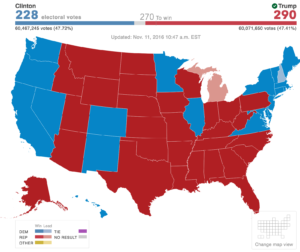It was 12:30am. Our 14 year old was still up watching the election results: “I want to stay up because in the next presidential election — I will be able to vote.” It felt like when she learned to ride her bike, or when I waved goodbye as she hopped on the commuter train alone to go to high school for the first time. We have 4 years. Four years to teach her how to be a good citizen – how to evaluate who to vote for, but even more importantly, how to be actively engaged so that the men and women who are asking for her vote actually represent her values and her priorities.
This election was like no other. America was America and people voted. Peggy Noonan hinted at this election result back in February 2016 in her OpEd “Trump and the rise of the unprotected”. “ The protected are the accomplished, the secure, the successful—those who have power or access to it. They are protected from much of the roughness of the world. More to the point, they are protected from the world they have created. Again, they make public policy and have for some time. They’re insulated from many of the effects of their own decisions. The unprotected live in it. The unprotected are starting to push back, powerfully. (…) This is a terrible feature of our age—that we are governed by protected people who don’t seem to care that much about their unprotected fellow citizens.
And a country really can’t continue this way.”
People thought for themselves. By August 2016, unions had already spent an unprecedented amount in this election supporting Democrats and Hillary Clinton: $108 million – up from 38% in the last cycle. Labor Unions knocked on 1 million doors in Ohio. The National Education Association had spent $14 million, up from $7.7 million last cycle (here’s the WSJ article). Yet, people went against their union bosses in Ohio, Wisconsin, Florida, Pennsylvania, and most likely Michigan, and voted independently — voted for Trump.
Clinton outspent Trump by 2 to 1. Here are some numbers: Trump raised a total of $512 million, versus Clinton who raised close to $1 billion (Bloomberg has a great breakdown). Contributions of $200 or less accounted for about 64% of Trump total donations from individual citizens. By contrast, about 26% of Clinton’s donations through Oct. 19 came in amounts that small. California billionaire Tom Steyer, who directed more than $60 million of his hedge-fund fortune to help persuade voters to turn out for Democrats, instead saw a Republicans sweep that would give them control of the White House and both chambers of Congress. People did not follow California’s “intellectual leadership”.
Women in this Election? While 53% of white women voted for Trump, 68% of hispanic and latinos and 94% of black women voted for Clinton. This election saw Kellyanne Conway become the first woman to manage a Republican presidential candidate campaign. And 37 women were among the top 150 donors to super PACs. This election changes the narrative on women and how they vote and who they support. Here’s the link to our post about Women in the 2016 Election.
Anxiety beats depression. At 2am, I was reminded of what Peggy Noonan wrote in her September OpEd “Can Anxiety beat Depression?” that “in America, anxiety beats depression because it’s the more awake state.” That was the case everywhere, except in Washington DC where Secretary Clinton won by 92% of the vote. DC does not like anxiety.
However, when you add up the votes nationwide for Mrs. Clinton, Jill Stein, Gary Johnson and others, you get roughly 52%. Between 47% and 48% voted for Mr. Trump. “It was an enormous achievement but a close-run thing, and precarious,” to quote Peggy Noonan (@peggynoonannyc) again.
Now what? This election reminds us that perhaps the best way to prepare the teenagers in our lives to become real citizens is to model civic engagement for them. In Ancient Greece, Athenians took an oath that ends with “We will strive unceasingly to quicken the public’s sense of civic duty, that thus, in all these ways, we will transmit this city not only not less, but greater, better, and more beautiful than it was transmitted to us.”
At the Policy Circle, circles are discussing a new brief recently added to our Year of Conversations on The What’s and Why’s of Civic Engagement . This is our country. And this presidency needs all of us to be engaged. Let’s start the conversation and actively participate in setting the agenda for America.
If you are a member Recommend a Circle Leader, especially in Wisconsin, Minnesota, Arizona, and NY.
If you are not a member, then Start a Circle in your neighborhood. Join us; be part of the conversation at this critical and momentous time.
The Policy Circle provides a fact-based, nonpartisan framework that inspires women living in the same community to connect, learn about and discuss public policies that impact their lives. The Policy Circle Roundtable discussions empower women to become more vocal in public policy dialogue and civic engagement within their community, their state and their country.
The Policy Circle is a 501(c)(3) non-profit.
Be part of network of women who want to assume their civic duties and understand the impact of policy in their lives. Invest in The Policy Circle.
